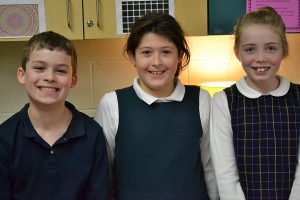 Our Philosophy
Our Philosophy
Our St. Francis School fourth-grade program encourages the students’ greater sense of responsibility to others and to themselves. Basic Catholic values are taught and applied to all facets of the curriculum so students view themselves as contributing members of God’s family.
Fourth-grade students increase their view of the world through a balance of rigorous academic expectations and extracurricular activities. We help each child grow less egocentric as we enforce following directions, being respectful, and being responsible.
Fourth-Grade Curriculum
Religion
The religious education program centers on the Ten Commandments in fourth grade. Students use the Spirit of Truth text from Sophia Press and complete in-depth studies of each commandment. Spirit of Truth also comes with at-home connections for family formation and online resources. We supplement this with the Education in Virtue Program, which covers the habits necessary to grow as a disciple of Christ. Students are exposed to the Corporal and Spiritual Works of Mercy. Students are exposed to God’s full plan for our salvation. We trace His promise from Adam and Eve to the cross. They memorize, compose and learn many prayers. They review an Examination of Conscience and the purpose of the Sacrament before we receive Reconciliation. A comprehensive study of the rosary is also covered.
Reading
Novels are taught using the comprehension strand of Project Read. Research, comprehension, vocabulary, fluency skills as well as dictionary skills are taught. We also supplement our program with the Accelerated Reader program. Several genres of books are covered.
English
Basic grammar is covered and students are guided through a writing assignment after a grammar unit is completed. Process writing includes stories using the Project Read story form, five-paragraph essays: expository and persuasive, diary form, fractured fairy tales and some poetry. Punctuation and capitalization rules are taught, practiced, and enforced. Students keep a writing notebook of their compositions.
Spelling
Pre-tests are given every Wednesday followed by a final test on Friday. Spelling units are introduced every Friday and work is done independently during the following week. Student’s use Zaner-Bloser’s Spelling text.
Handwriting
Students review the cursive alphabet with the use of Zaner-Bloser’s Handwriting. Letter formation, strokes, slants, and spacing are reinforced throughout the year. Good handwriting is expected in all work. Handwriting also connects to our weekly spelling words.
Social Studies
Classroom economy is a main focus point in 4th grade. Students apply, interview and are hired for jobs for which they receive paychecks and pay taxes. They use their pay to buy items in our classroom stores and purchase tickets to travel around the United States in groups. In these groups they study the regions by reading the book to fill out travel notes (packets) and watch videos and do activities to help make connections.
Math
Our math program, Savvas enVision series, comes with a wide variety of resources that can be found online. Students are encouraged to develop a flexible mathematical mindset, learning and applying multiple methods of solving problems, in addition to developing solid procedural fluency.
Science
Mystery Science encompasses the study of life science, physical, and earth science, the scientific method, and weekly labs. Report writing and a Science Fair experiment are also part of the fourth-grade science curriculum.
Enrichment
Spanish
Fourth graders continue developing their reading, writing and conversational skills. Students learn to count by tens and are introduced to more complex grammatical concepts such as definite and indefinite articles to talk about nouns. Students are able to recognize classroom instructions and vocabulary in Spanish and use basic greetings. Students also learn about the Hispanic culture and Catholic faith with short prayers, songs and traditions.
Specials
Each week our fourth graders participate in art, music, PE, library and technology. They also enjoy participating in the Christmas program and the option of Elementary School Choir.
Fourth-Grade Play
Try-outs and rehearsals are held each February for the fourth-grade musical performed in May. Students learn basic acting and blocking skills. This is an exciting four-month project.
Recess/Lunch
Every day, fourth graders enjoy a 25 minute lunch period followed by 25 minutes of outdoor recess time. Recess and lunch are supervised by parent helpers.
How to Get Ready for Fourth Grade
Many children find the transition to fourth grade challenging. Here are some tips to help you prepare.
- Practice cursive over the summer
- Keep a journal
- Read for 15 to 20 minutes daily
- Review basic math facts
Fourth-Grade Survival Tips
When you’re a fourth grader, here are some survival tips to ensure your success.
- Keep your assignment book up to date and have your parents check it daily
- Learn to study for weekly quizzes and tests
- Understand the importance of vocabulary and bold-faced headings
- Capitalize and punctuate properly every time
- Learn some test-taking skills
- Edit! Edit! Edit! Quality of work is most important